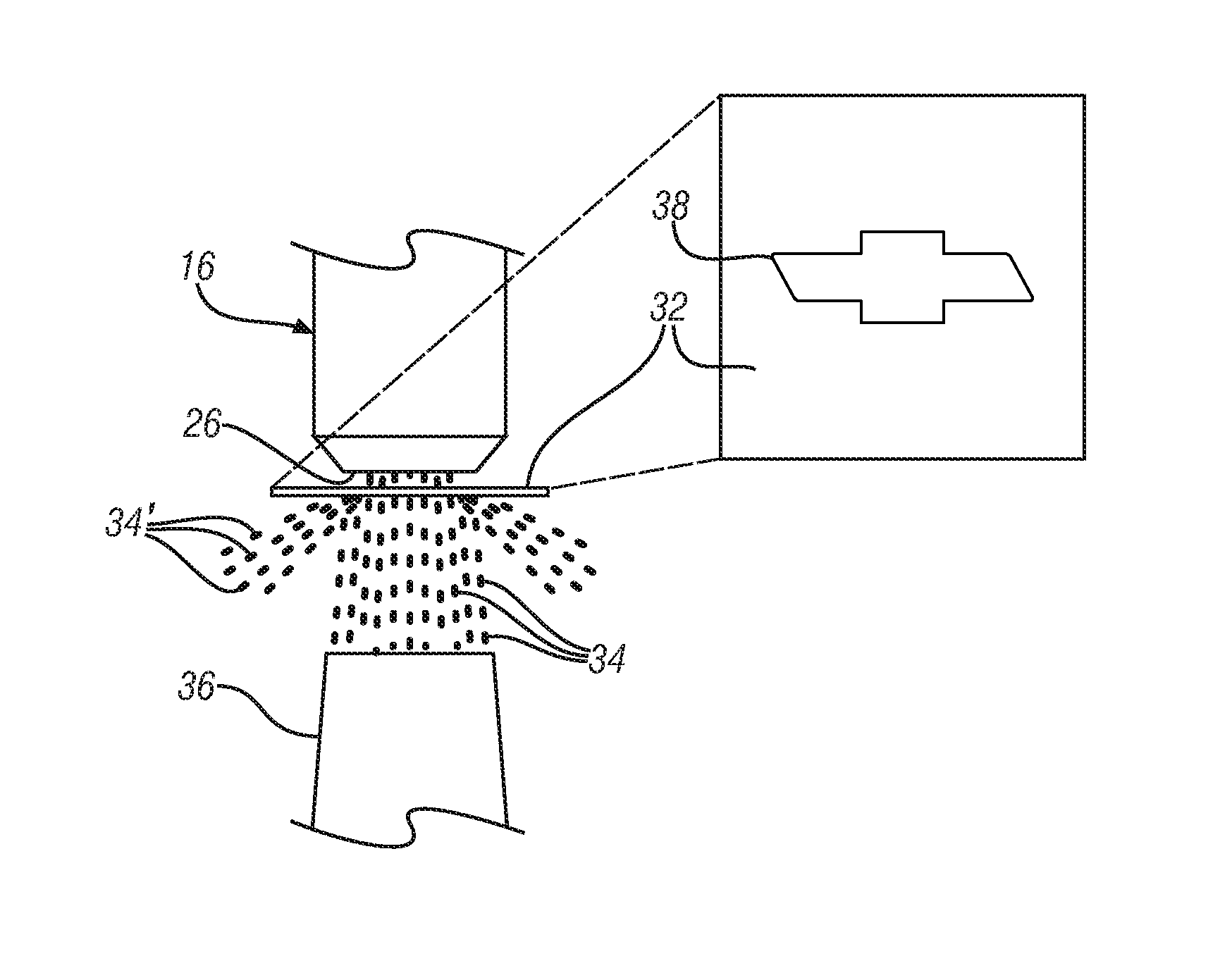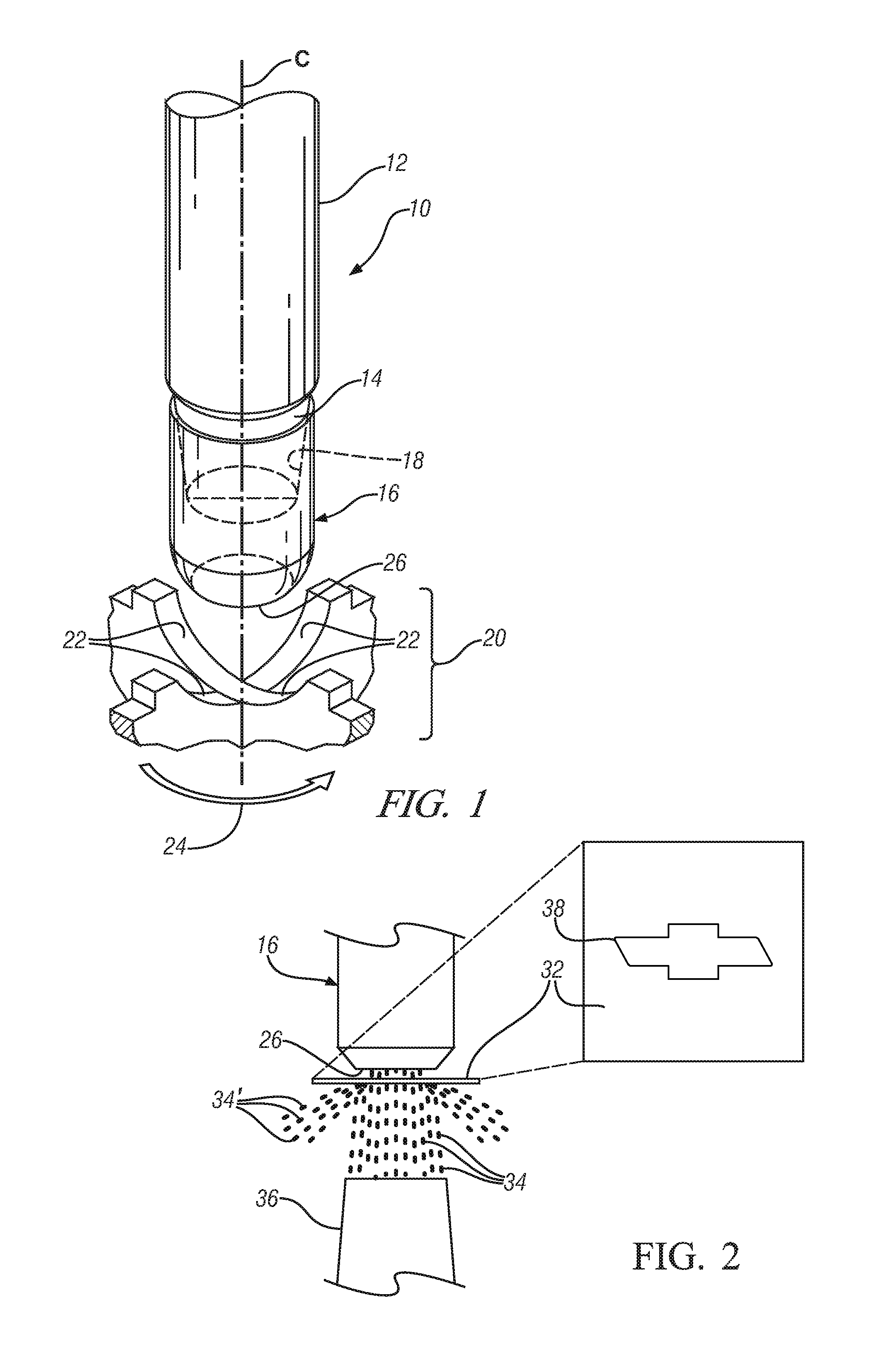Application of surface relief to spot welding electrodes
a surface relief and welding electrode technology, applied in the direction of electrical components, soldering equipment, manufacturing tools, etc., can solve the problems of unattractive sheet deformation around the weld, excessive indentation and/or unsightly sharp imprint on the steel surface, and undesirable whiskers or fingers of metal protruding from the sheet surface, so as to reduce production disruption and quickly and efficiently introduce specific patterns
- Summary
- Abstract
- Description
- Claims
- Application Information
AI Technical Summary
Benefits of technology
Problems solved by technology
Method used
Image
Examples
first embodiment
[0032]In a first embodiment, shown in FIGS. 2 and 3, an abrasive material removal process is used to create a 1 μm to 30 μm Ra rough surface. One such abrasive removal process, shown in FIG. 2, is grit blasting which may be performed using sand or steel grit media propelled against the surface by means of a high pressure (50 to 150 pounds per square inch) gas flow. Alternatively the cap may be brushed with stainless steel wire or silicon carbide-impregnated nylon brushes as shown in FIG. 3. Independently of the abrasive removal process selected, a mask with suitably-shaped opening is interposed between the abrasive medium and the weld cap. The mask will partially restrict access of the abrasive to the cap and thereby ensure that the abrasive process will create the desired form on the weld cap. Such a mask is usually used where the weld face presents a uniform composition across the face to the abrasive removal process.
[0033]In FIG. 2, electrode 16 is subjected to a stream of abrasi...
second embodiment
[0036]In a second embodiment, shown in FIG. 4, the pattern is imparted by electrical discharge machining and is capable of developing patterns with substantial differences in elevation on the electrode. An overview of the process is indicated at 70. By immersing the workpiece-contacting surface of the electrode in a bath of circulating (circulation system not shown) liquid dielectric 78, for example kerosene, and applying an increasing electrical potential, generated by power supply 80, between the electrode and a tool, an electrical discharge 74 will result. This discharge will vaporize a portion of the electrode 16 and a portion of the tool 72. However by fabricating the tool of a material with a high melting point and thus a high vaporization temperature, such as graphite or any of the refractory metals, the bulk of the vaporization will occur at the lower melting point copper-based electrode. This will introduce small particles of condensed copper-based alloy 75 into the electro...
third embodiment
[0037]In a third embodiment, illustrated in FIG. 5, the desired pattern may be imparted to the electrode by a mechanical upsetting process resulting from contact with a die as shown at 60. The electrode 16 is deformed by contact with rigid tool 62. Thus, the inverse geometry of the contact surface 66 of tool 62 is transferred to workpiece-contacting surface 26 of electrode 16. The required contact pressure P between the tool and the electrode may be generated by the weld apparatus or externally generated, for example by electromagnetically or explosively accelerating a compact tool electromagnetically to impact the electrode (not shown).
[0038]Preferably the electrode 16 will be heated to a temperature sufficient to reduce its flow stress prior to upsetting, for example by exposure to a tool 62 which has been heated by heater elements 64. Alternatively the electrode may be heated by passage of electric current through the electrode. An appropriate upsetting temperature will be alloy ...
PUM
| Property | Measurement | Unit |
|---|---|---|
| temperature | aaaaa | aaaaa |
| temperature | aaaaa | aaaaa |
| temperature | aaaaa | aaaaa |
Abstract
Description
Claims
Application Information
 Login to View More
Login to View More - R&D
- Intellectual Property
- Life Sciences
- Materials
- Tech Scout
- Unparalleled Data Quality
- Higher Quality Content
- 60% Fewer Hallucinations
Browse by: Latest US Patents, China's latest patents, Technical Efficacy Thesaurus, Application Domain, Technology Topic, Popular Technical Reports.
© 2025 PatSnap. All rights reserved.Legal|Privacy policy|Modern Slavery Act Transparency Statement|Sitemap|About US| Contact US: help@patsnap.com



